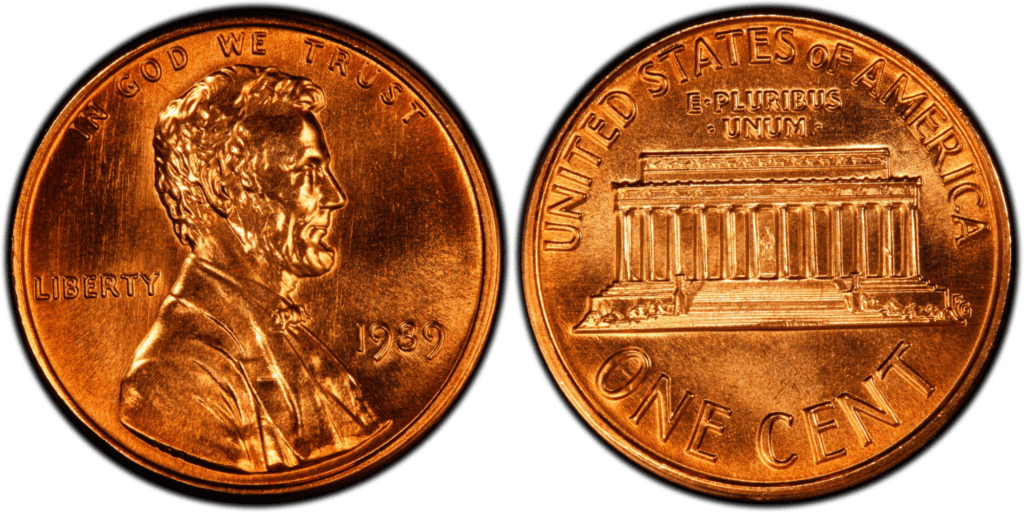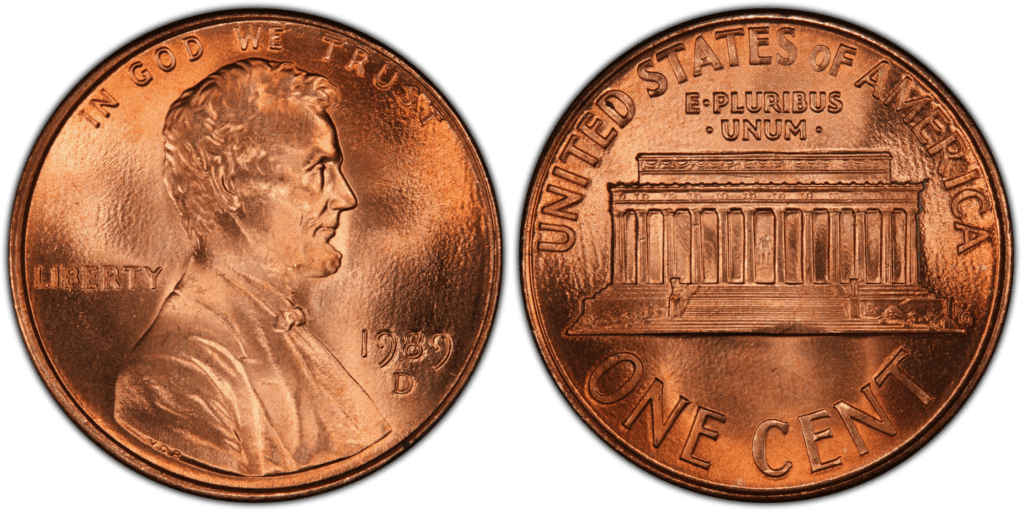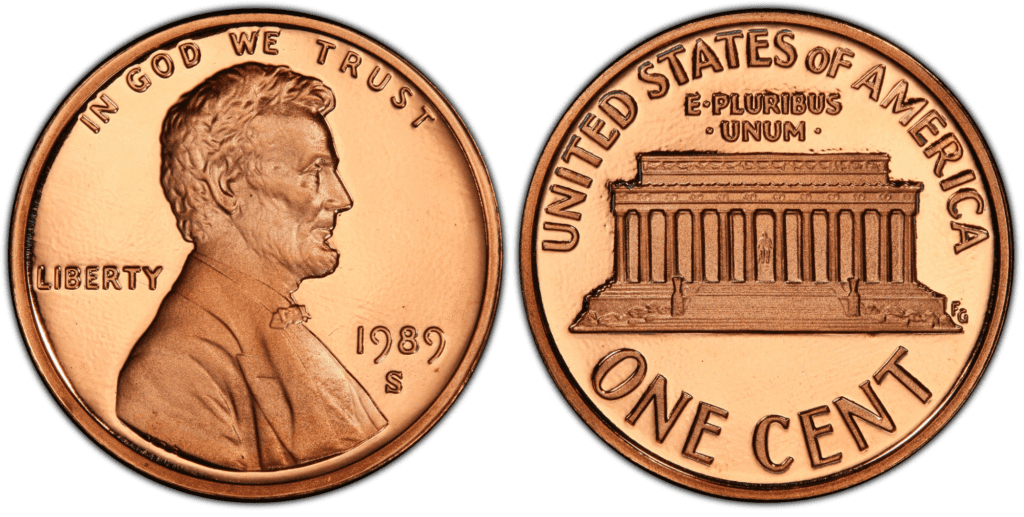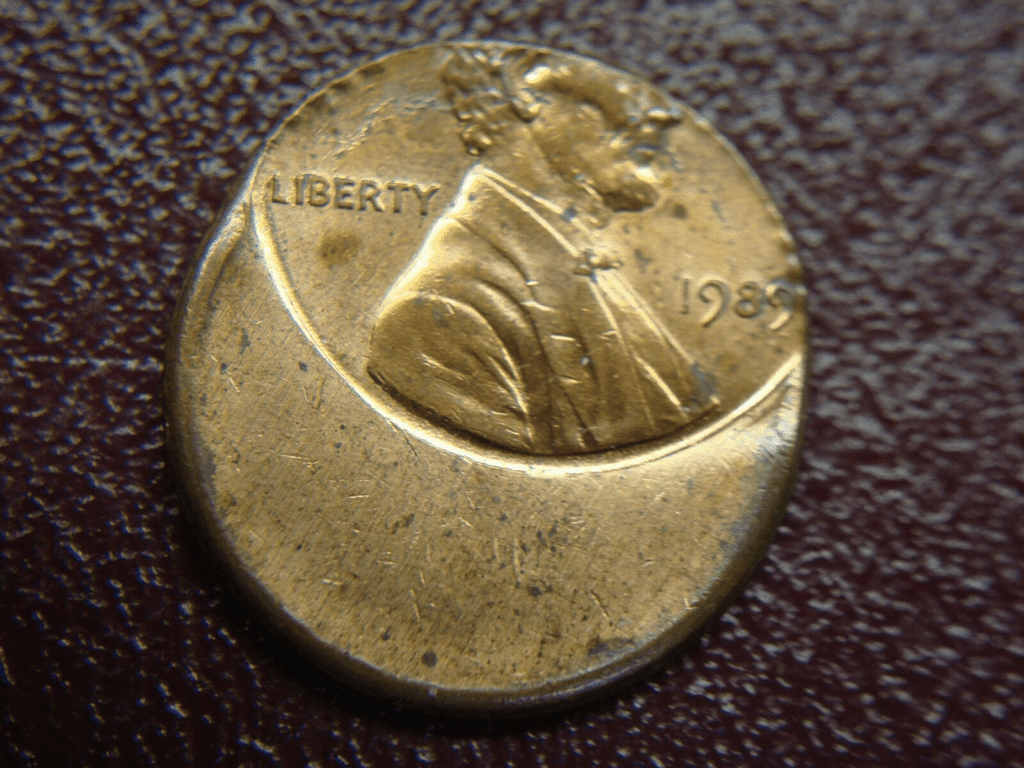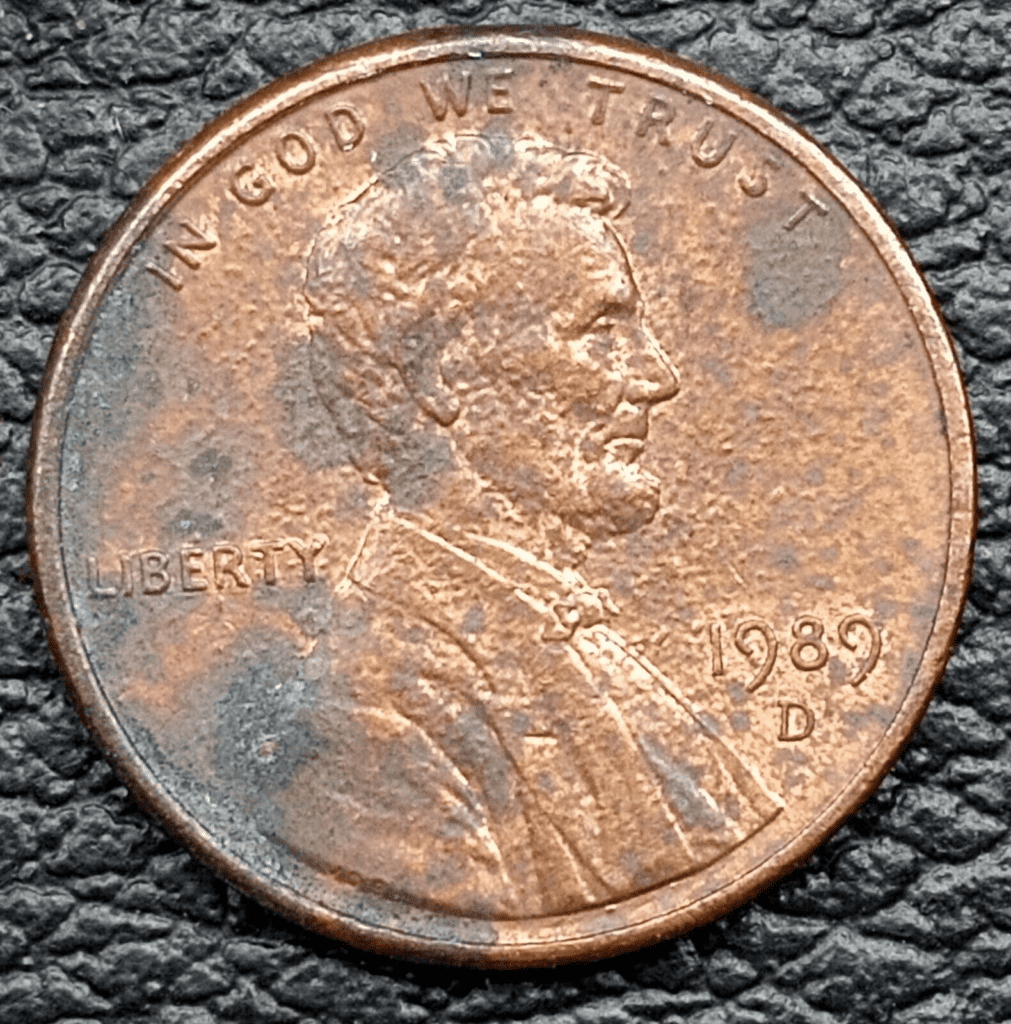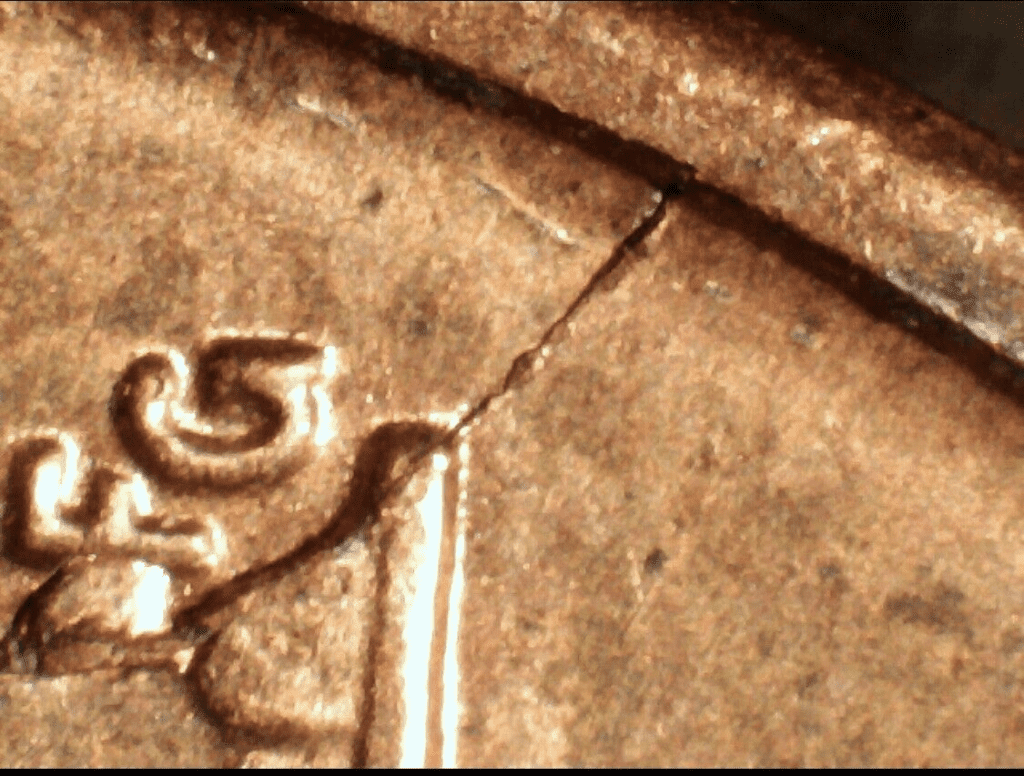What Is the 1989 Lincoln Penny Made Of?
The 1989 Lincoln penny is made of 2.5% copper and 97.5% zinc. It has a mass of 2.5 grams, a plain edge, and a diameter of 19.05 mm. Before 1909, pennies were made with different designs and compositions. For example, pennies come with flowing hair chains, flowing hair wreath, liberty cap, and draped bust designs, just to name a few.
Compositions also include bronze, zinc, and tin in the past.
The 1989 Lincoln penny is sometimes called the Lincoln cent. It was first struck in 1909, which is also the centennial birthday of Abraham Lincoln, the 16th president of the United States. It has a face value of one cent.

photo source: USA Coin Book
The obverse of the 1989 penny features the right profile of Abraham Lincoln, which Victor David Brenner designed. Inscriptions include, “IN GOD WE TRUST” which arches on top of Lincoln’s head.
On the left side of the coin is where “LIBERTY” is written. On the right side is where you find the year, 1989 plus the mint mark if present.
The reverse side showcases the Lincoln Memorial, which is fitting to be partnered with Lincoln’s bust. Frank Gasparro designed the reverse of the 1989 penny. The penny used the Lincoln Memorial design starting in 1959 until 2008.
Inscriptions include the following:
- United States of America
- One Cent
- E Pluribus Unum
1989 Lincoln Penny Varieties
There are different 1989 Lincoln pennies and they most differ based on their mint marks. Some became a unique type because of minting errors. Let’s take a look at some of them.
1989 Philadelphia (No-mintmark) Penny
Year of minting: 1989
Mint Mark: No mark
Place of minting: Philadelphia
Quantity produced: 7,261,535,000
Face Value: $0.01 (one cent)
Price: $0.01 to $2.00 (or more)
Mass: 2.5 grams
Edge: Plain
Designer: Victor D. Brenner
Composition: 97.5% zinc and 2.5% copper
Diameter: 19.05 mm
Thickness: 1.52 mm

photo source: PCGS
The no-mint 1989 penny was made in the Philadelphia Mint. The Mint produced more than 7.2 billion pennies and you can sell one of these for about $0.01 to $2.00.
1989-D Penny
Year of minting: 1989
Mint Mark: D
Place of minting: Denver
Quantity produced: 5,345,467,111
Face Value: $0.01 (one cent)
Price: $0.01 to $2.00 (or more)
Mass: 2.5 grams
Edge: Plain
Designer: Victor D. Brenner
Composition: 97.5% zinc and 2.5% copper
Diameter: 19.05 mm
Thickness: 1.52 mm

photo source: PCGS
The Denver Mint produced more than 5.3 billion 1989-D pennies. If you want to buy one of these or you have a penny to sell, you can expect that the value of the coin is around $0.01 to $2.00.
1989-S (San Francisco) Proof Penny
Year of minting: 1989
Mint Mark: S
Place of minting: San Francisco
Quantity produced: 3,220,194
Face Value: $0.01 (one cent)
Price: $0.01 to $2.00 (or more)
Mass: 2.5 grams
Edge: Plain
Designer: Victor D. Brenner
Composition: 97.5% zinc and 2.5% copper
Diameter: 19.05 mm
Thickness: 1.52 mm

photo source: PCGS
The San Francisco Mint produces proof coins. As expected, because these coins are difficult to produce, only about 3.2 million 1989-S pennies were created. Nevertheless, the proof pennies are more attractive and detailed.
List Of 1989 Lincoln Penny Errors
With billions of 1989 Lincoln pennies, you can expect that there were a few of these pennies produced with some errors. Here are some examples:
1989 Lincoln cud errors

photo source: YouTube, MarkedMoneyTech
In this error, the coin seems to have a folded edge. As a result, some inscriptions were partially and fully covered. This happened due to an error on the planchet.
1989-P Lincoln Cent Mint Off-center error

photo source: eBay
The coin with an off-center strike looks like a quarter moon. Because of misalignment, the die didn’t hit the planchet exactly as expected. As a result, part of the engraved material is placed outside of the coin. Some inscriptions are completely and partially missing.
1989-D Lincoln Improper Annealed Cloth Struck

photo source: eBay
Annealing is the process of heating and cooling the planchet repeatedly to make it less brittle. This allows the planchet to be more malleable. However, in this coin, the annealing process wasn’t done properly. Thus, the coin got some discolorations.
1989 Penny Die Break Error

photo source: eBay
Due to repeated strikes, the die can fail and break. Once it breaks, you’ll see the cracks in the coin as you can see in the photo above.
How Much Is 1989 Lincoln Penny Worth Today?
1989 Lincoln pennies aren’t that expensive. If you want to collect them, then you should be able to buy one at an affordable price.
As mentioned, the face value of 1989 pennies is just one cent. Its melt value is $0.0075. So, if you’re selling a 1989 Lincoln penny, you might be able to sell it for as much as $2.
Nevertheless, there are some 1989 pennies that are worth more, especially those that are still in pristine condition. Moreover, if you have 1989 pennies with rare attributes, then that would also increase their value.
Here’s a comparison table to help you know more about the value of a 1989 Lincoln penny.
|
Coin |
Condition |
Grade |
Mintage |
Value |
|
1989 Philadelphia (No-mintmark) Penny |
circulated/Mint |
Not graded |
7,261,535,000 |
$0.01-$2.00+ |
|
1989-D Penny |
circulated/Mint |
Not graded |
5,345,467,111 |
$0.01-$2.00+ |
|
1989-S (San Francisco) Proof Penny |
circulated/Mint |
Not graded |
3,220,194 |
$0.01-$1.00+ |
|
1989 Philadelphia (No-mintmark) Penny |
uncirculated/Mint |
MS-66 |
7,261,535,000 |
$7.00-$20.00+ |
|
1989 Philadelphia (No-mintmark) Penny |
uncirculated/Mint |
MS-67 |
7,261,535,000 |
$14.00-$34.00+ |
|
1989 Philadelphia (No-mintmark) Penny |
uncirculated/Mint |
MS-68 |
7,261,535,000 |
$104.00-$564.00+ |
|
1989-D Penny |
uncirculated/Mint |
MS-66 |
5,345,467,111 |
$7.00-$18.00+ |
|
1989-D Penny |
uncirculated/Mint |
MS-67 |
5,345,467,111 |
$7.00-$22.00+ |
|
1989-D Penny |
uncirculated/Mint |
MS-68 |
5,345,467,111 |
$84.00-$264.00+ |
|
1989-S (San Francisco) Proof Penny |
uncirculated/Mint |
PR-68 |
3,220,194 |
$7.00-$22.00+ |
|
1989-S (San Francisco) Proof Penny |
uncirculated/Mint |
PR-69 |
3,220,194 |
$9.00-$140.00+ |
|
1989-S (San Francisco) Proof Penny |
uncirculated/Mint |
PR-70 |
3,220,194 |
$51.00-$175.00+ |
Are There Any Rare 1989 Lincoln Penny?
Yes, there are rare 1989 Lincoln one-cent coins based on what condition they are in. For example, 1989 pennies that received a grade of MS-66 and PR-68 and above are rare because there are only a few 1989 pennies with this grade.
Now, if you are looking for a really rare 1989 Lincoln penny, you need to find the 1989-D pennies. These pennies are rare because of an error made in the US Mint.
In 1982, the pennies were supposed to transition from copper to zinc. However, in 1989, some 95% copper planchets were included in the minting process. These planchets are supposed to be leftover planchets from 1982. The error was immediately detected and so, there are only a few of these 1989-D copper pennies.
You might be asking, “How much is the 1989-D copper penny?” Answer: a lot!
Just to give you an idea, in August 2016, a 1989-D copper penny was sold for $3,525 in an auction. Now, that’s a lot of money.
Now, the next question you might have is this, “How can I know if my 1989-D penny is made of copper?”
First off, you can weigh your coin. Copper is heavier than zinc. A penny made of zinc is just around 2.5 grams. However, a penny made of copper is about 3.11 grams.
You can also do a drop test. Of course, you need to be skilled enough to hear the difference. Zinc-based pennies make a dull sound while copper-based pennies make a bell-like ring during a drop test.
If you really want to be sure, you can approach a coin appraiser or get in touch with numismatic experts. They should be able to tell you whether your coin is a rare penny or not. Be sure to only work with reputable and trusted providers.
How Does The Grading System Work?
The Sheldon Scale is used by numismatists to provide a numerical value to coins. The Sheldon Scale goes from poor (P-1) to perfect mint state (P-1) (MS-70). Coins were originally evaluated using words to reflect their condition (Good, Fair, Excellent, Etc.). Unfortunately, coin collectors and dealers had different ideas about what each of these terms represent.
Professional numismatists joined together in the 1970s and established CoinGrading standards. These numismatists now assign grades at key places on the seventy-point scale, using the most regularly utilized numeric points in conjunction with the original adjective grade. The following are the most common coin grades:
-
-
- (P-1) Poor – Indistinguishable and probably damaged; if used, must have a date and mintmark; otherwise, rather battered.
- (FR-2) Fair – Nearly smooth, but without the damage that a coin graded Poor often possesses. The coin must have enough detail to be identified.
- (G-4) Fair – Inscriptions have merged into the rims in some areas, and important elements have been mostly erased.
- (VG-8) Very Good- A little weathered, but all of the primary design elements are visible, albeit faintly. There is little if any, central detail left.
- (F-12) Good – The item is very worn, yet the wear is even, and the overall design details stand out clearly. Rims are almost completely isolated from the field.
- (VF-20) Very Fine – Moderately weathered, with some finer features still visible. The motto or all letters of LIBERTY are readable. Both sides of the coin have entire rims that are separated from the field.
- (EF-40) Extremely Fine – Gently used; all gadgets are visible, and the most important ones are bold. The finer details are bold and clear, however, light wear may be seen.
- (AU-50) Uncirculated – Slight evidence of wear on the coin’s design’s high points; may have contact marks; eye appeal should be adequate.
- (AU-58) Uncirculated Choice – Slight traces of wear, no severe contact marks, almost full mint shine, and great eye appeal.
- (MS-60) Mint State Basal – Strictly uncirculated; no indication of wear on the coin’s highest points, but an unsightly coin with reduced luster, visible contact marks, hairlines, and other flaws.
- (MS-63) Mint State Acceptable – Uncirculated, but with contact scratches and nicks, little reduced shine, but otherwise appealing appearance. The strike is weak to average.
- (MS-65) Mint State Choice – Uncirculated with great mint shine, very little contact blemishes, and exceptional eye appeal. The strike is unusually severe.
- (MS-68) Mint State Premium Quality – Uncirculated with superb luster, no obvious contact marks to the naked eye, and exceptional eye appeal. The strike is quick and appealing.
- (MS-69) Almost Perfect Mint State – Uncirculated with perfect brilliance, a sharp and appealing strike, and extremely good eye appeal. A near-perfect coin with minor imperfections in the planchet, strike, and contact markings (seen only under 8x magnification).
- (MS-70) Mint State Perfect – Under 8x magnification, there are no tiny imperfections discernible; the strike is crisp, and the coin is perfectly centered on a beautiful planchet. Rarely seen on a coin, this coin is bright and whole, with original luster and exceptional eye appeal.
-
Where To Buy Or Sell 1989 Lincoln Penny?
The 1989 Lincoln penny is available online. You can visit websites such as Amazon, Etsy, and eBay.
Aside from the Internet, you can visit coin collectors’ hubs. You can meet with other hobbyists and collectors to form a network of contacts and find a place to buy and sell 1989 Lincoln one-cent coins.
You can also get in touch with coin shops and auction houses. These places offer some of the best 1989 Lincoln pennies.
FAQs
Is There A Rare 1989 Penny Worth $3,000?
Yes, there is a rare 1989 penny worth $3,000. This penny was struck in Denver. The Mint inadvertently struck a 1989 penny on a copper planchet.
What is the 1989 Penny no mint mark value today?
Circulated and standard struck 1989 no-mark penny is usually about $0.01 to $2.
What is the 1989 Penny copper planchet error?
The 1989 penny copper planchet error happened when the Denver Mint accidentally used copper planchets instead of zinc planchets. This made the 1989-D copper planchet extremely rare and valuable.
1979 Dime Value Guide
1987 Quarter Value Guide (Incld. Rare Varieties)
1988 Washington Quarter Value Guide (Incld. Rare Varieties)
1989 Jefferson Nickel Value Guide (Incld. Rare Varieties)
1989 Washington Quarter Value Guide (Incld. Rare Varieties)


